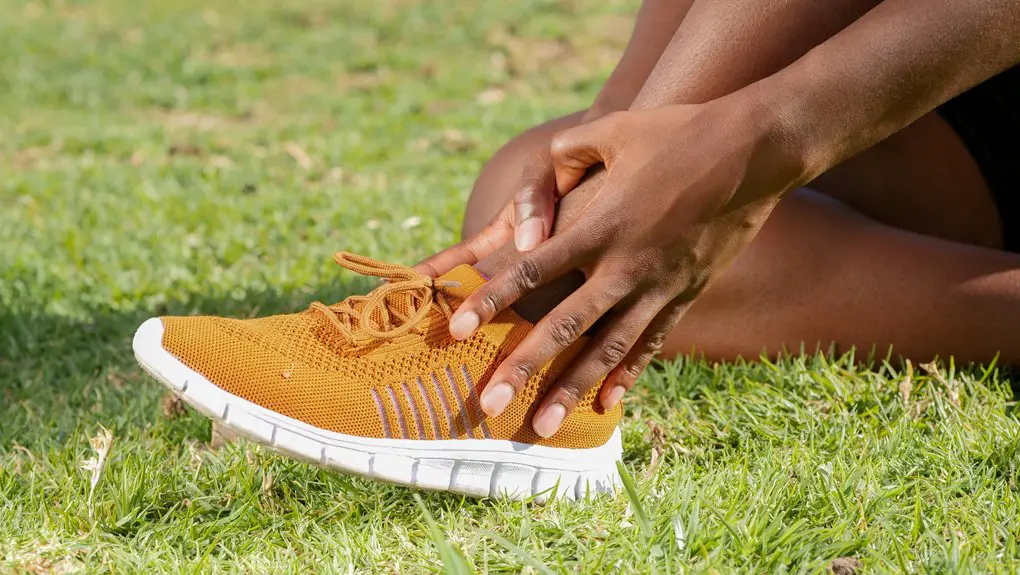To reduce ankle and foot pain after standing all day, try calf stretches and toe raises to improve flexibility and strength. Wear properly fitted shoes with arch support and cushioned insoles. Ice your feet to relieve pain and reduce swelling. Elevate your feet for better circulation, and stay hydrated throughout the day. Gentle massage or warm foot soaks can help relax tired muscles. Want more tips on alleviating discomfort? Keep going!
Table of Contents
Key Takeaways
- Perform calf stretches and toe raises to enhance flexibility and strengthen foot muscles after standing all day.
- Choose proper footwear with arch support and cushioned insoles to reduce strain on your feet.
- Use ice therapy and massage techniques to alleviate pain and reduce inflammation effectively.
- Elevate your feet using a footrest and stay hydrated to improve circulation and reduce swelling.
- Seek professional help if pain persists, mobility is limited, or swelling does not subside.
Stretching Exercises for Relief
When you’ve been standing for long periods, incorporating stretching exercises can greatly alleviate ankle and foot pain.
Start with calf stretches by placing your hands on a wall, stepping one foot back, and pressing your heel into the ground. Hold for 15-30 seconds, then switch sides.
Next, try the seated toe stretch: sit with one leg extended, reach for your toes, and hold for 15 seconds.
For your arches, roll a tennis ball under your foot, applying gentle pressure.
Finally, don’t forget to stretch your ankles; sit with your foot elevated and rotate it in circles.
These simple stretches can improve flexibility and circulation, helping reduce discomfort and keep you on your feet longer without pain.
Proper Footwear Choices
Stretching exercises can only do so much if your footwear isn’t up to par.
Stretching alone won’t alleviate discomfort if your shoes aren’t supportive and well-fitted.
Wearing the right shoes is essential for preventing ankle and foot pain after standing all day. Look for footwear that offers support, cushioning, and stability.
Here are some key features to take into account:
- Arch support: Confirm your shoes provide adequate support to maintain proper foot alignment.
- Cushioned insoles: Opt for shoes with cushioned insoles to absorb impact and reduce strain on your feet.
- Proper fit: Verify your shoes fit well, allowing enough room for your toes and preventing blisters.
Using Ice Therapy
If you’re dealing with ankle and foot pain, ice therapy can be a game changer.
Applying ice correctly not only numbs the pain but also reduces inflammation.
Let’s explore the benefits, proper techniques, and how often you should use ice for the best results.
Benefits of Ice Therapy
Ice therapy offers a simple yet effective way to alleviate ankle and foot pain after prolonged standing. By applying ice, you can experience several benefits that help your recovery process. Not only does it reduce inflammation, but it also numbs the pain, making it easier to relax and unwind.
- It promotes better blood circulation, aiding in quicker healing.
- It helps decrease swelling, allowing for more comfortable movement.
- It can enhance your overall comfort, letting you enjoy your time on your feet.
Incorporating ice therapy into your routine can make a significant difference in how you feel after a long day.
You’ll find that regular use not only soothes your feet but also enhances your overall well-being.
Proper Ice Application Techniques
To effectively relieve ankle and foot pain, knowing the right way to apply ice is essential. Start by choosing an ice pack or a bag of frozen peas wrapped in a towel. Apply it to the affected area for best results.
Here’s a quick reference table to guide you:
| Technique | Description |
|---|---|
| Direct Application | Place the ice pack directly on the skin for 10-15 minutes. |
| Elevation | Elevate your foot while applying ice to enhance circulation. |
| Compression | Use a compression wrap alongside ice for added support. |
Frequency and Duration Guidelines
Applying ice therapy effectively involves knowing how often and for how long to use it. To maximize its benefits for your ankle and foot pain, adhere to these frequency and duration guidelines:
- Frequency: Apply ice every 2 to 3 hours, especially after prolonged standing or physical activity.
- Duration: Keep the ice on for 15 to 20 minutes at a time to prevent skin damage and guarantee ideal relief.
- Rest Period: Allow your skin to warm up for at least 40 minutes between applications to avoid frostbite.
Elevation Techniques
To help alleviate ankle and foot pain, elevating your legs can make a big difference.
You can achieve this by using proper leg positioning, pillows, and even compression techniques.
Let’s explore how each of these methods can provide relief and support your recovery.
Proper Leg Positioning
While standing for long periods can lead to discomfort, using proper leg positioning through elevation techniques can greatly alleviate foot and ankle pain.
By adjusting your leg position, you can improve circulation and reduce strain.
Try incorporating these strategies:
- Elevate your feet: When sitting, use a footrest or stool to keep your feet elevated.
- Shift your weight: Alternate your weight between legs to minimize fatigue.
- Stretch regularly: Take breaks to stretch your calves and ankles, promoting flexibility.
Use of Pillows
Using pillows for elevation can greatly enhance your comfort after long periods of standing.
When you elevate your feet, you help reduce swelling and improve circulation. Grab a couple of firm pillows and place them under your feet and lower legs when you sit or lie down. This simple adjustment encourages blood flow back toward your heart, easing discomfort in your ankles and feet.
Make sure the elevation is comfortable; you don’t want to strain your legs or back. You could also try lying on your back with your feet resting on a wall, which can be particularly soothing.
Incorporating pillow elevation into your routine can make a significant difference in how you feel after a long day.
Compression Techniques
Compression techniques can be a game changer for relieving ankle and foot pain after long periods of standing. By applying pressure to your feet and ankles, you can improve circulation and reduce swelling.
Here are some effective methods you can try:
- Compression socks: These help provide support and improve blood flow, easing discomfort.
- Wraps or sleeves: An elastic wrap can be adjusted for comfort, targeting specific areas of pain.
- Cold therapy: Applying a cold compress after compression can further reduce inflammation and soothe sore muscles.
Incorporating these techniques into your routine can make a significant difference in how your feet feel at the end of the day.
You’ll find that your recovery time improves, allowing you to stay on your feet longer without discomfort.
Massage for Tired Feet
After a long day of standing, nothing soothes tired feet quite like a good massage. You can start by using your thumbs to apply gentle pressure to the soles, focusing on any tight areas.
Roll a tennis ball under your foot for a more targeted relief, helping to release tension in the arches. Don’t forget your heels and toes; they often bear the brunt of your day.
You can also soak your feet in warm water mixed with Epsom salt before massaging to enhance relaxation. If you’ve got a partner, consider trading foot massages—teamwork makes it more enjoyable!
Regular massages not only ease pain but also improve circulation, leaving your feet feeling revitalized and ready for another day.
Compression Socks Benefits
Foot massages can provide immediate relief, but if you’re looking for a way to support your feet throughout the day, compression socks might be the answer.
These socks apply gentle pressure to your feet and legs, helping improve circulation and reduce swelling. Plus, they offer a snug fit that can alleviate discomfort during long hours of standing.
Compression socks provide gentle pressure for improved circulation and reduced swelling, offering comfort during long hours of standing.
Benefits of compression socks include:
- Enhanced blood flow: They help your veins work more efficiently, reducing fatigue.
- Decreased swelling: Compression can minimize fluid buildup in your feet and ankles.
- Support for muscles: They provide stability and may prevent cramps or soreness.
Incorporating compression socks into your daily routine can make a significant difference in how your feet feel by the end of the day.
Staying Hydrated
Staying hydrated is essential, especially when you spend long hours on your feet. Proper hydration helps maintain blood circulation, which reduces swelling and discomfort in your ankles and feet.
When you’re dehydrated, your body retains water, leading to bloating and increased pressure on your lower extremities. Aim to drink water throughout the day, especially during breaks. Keep a water bottle handy to remind yourself to sip regularly.
You might also consider adding electrolyte-rich beverages if you sweat a lot. Eating water-rich foods like fruits and vegetables can further support your hydration efforts.
Foot Soaks and Baths
Maintaining proper hydration sets the stage for other effective methods to alleviate discomfort in your feet and ankles.
One of the most soothing ways to relieve pain is through foot soaks and baths. These warm treatments can help relax muscles, improve circulation, and reduce swelling.
Consider these options for your foot soaks:
- Epsom salt: Dissolve in warm water to ease tension and inflammation.
- Essential oils: Add lavender or peppermint for a calming effect and pleasant aroma.
- Herbs: Use chamomile or rosemary for their anti-inflammatory properties.
Strengthening Foot and Ankle Muscles
Strengthening the muscles in your feet and ankles can greatly reduce pain and improve stability. You can start with simple exercises like toe raises, where you lift your heels off the ground while standing.
Try calf stretches to enhance flexibility and strength as well. Balancing exercises, such as standing on one foot, can also engage your ankle muscles effectively.
Resistance bands are great tools—use them for ankle dorsiflexion and plantarflexion exercises. Incorporate these movements into your daily routine, aiming for 10-15 repetitions per exercise.
Remember to listen to your body; if something feels painful, ease off. By consistently strengthening these muscles, you’ll build endurance and reduce discomfort after long hours of standing.
When to Seek Professional Help
If you’re experiencing persistent pain that doesn’t improve with rest or home remedies, it’s time to contemplate professional help.
Watch out for signs of swelling and inflammation, as they could indicate a more serious issue.
Limited mobility can also be a red flag, signaling that you shouldn’t ignore your symptoms any longer.
Persistent Pain Concerns
Persistent pain in your ankles and feet can signal that it’s time to seek professional help. Ignoring this discomfort may lead to more serious issues down the line.
It’s essential to recognize when your pain isn’t just a temporary inconvenience.
Consider reaching out to a healthcare provider if you experience:
- Pain that lasts for several days without improvement
- Difficulty walking or bearing weight on your feet
- Persistent soreness that interferes with daily activities
These signs may indicate underlying conditions that require attention.
Early intervention can help prevent further complications and get you back on your feet faster.
Don’t hesitate to consult a professional; your well-being is worth it.
Swelling and Inflammation Signs
When you notice swelling or inflammation in your ankles and feet, it’s essential to pay attention, as these symptoms can indicate underlying issues that might need medical attention.
If the swelling persists for more than a few days or worsens, don’t hesitate to consult a healthcare professional. You should also seek help if you experience severe pain, redness, or warmth in the affected areas. These signs could point to conditions like deep vein thrombosis or infection.
Additionally, if your symptoms are accompanied by shortness of breath or chest pain, seek emergency care immediately.
Limited Mobility Issues
While experiencing limited mobility in your ankles and feet can be frustrating, it’s important to recognize when it signals a need for professional help.
If you notice any of the following issues, it’s time to consult a healthcare professional:
- Persistent pain that doesn’t improve with rest or home remedies.
- Difficulty walking or standing, especially when it affects daily activities.
- Swelling or stiffness that lasts longer than a few days.
Ignoring these signs can lead to further complications.
Seeking help early can provide you with the right diagnosis and treatment, ensuring your mobility improves.
Don’t hesitate to reach out for assistance; your health is worth it.
Frequently Asked Questions
Can Weather Conditions Affect Ankle and Foot Pain?
Yes, weather conditions can affect your ankle and foot pain. Cold or damp weather might increase discomfort, while warm, dry days often provide relief. Pay attention to the weather, as it can influence your symptoms.
Are There Specific Diets That Help Reduce Foot Pain?
While indulgent foods can lead to inflammation, a diet rich in anti-inflammatory options like leafy greens and omega-3s can actually help reduce foot pain. You’ll feel the difference when you choose wisely for your meals.
How Does My Weight Impact Foot and Ankle Pain?
Your weight considerably impacts foot and ankle pain. Extra pounds increase pressure on joints, leading to discomfort. Maintaining a healthy weight can help alleviate some of that strain, promoting better overall foot health and reduced pain.
Can Stress Contribute to Foot and Ankle Discomfort?
Yes, stress can definitely contribute to foot and ankle discomfort. When you’re stressed, your body tenses up, leading to increased muscle tension and pain in those areas. Managing stress can help alleviate some of that discomfort.
What Role Does Proper Posture Play in Foot Pain?
You might not realize it, but proper posture greatly impacts foot pain. When you maintain alignment, you distribute weight evenly, reducing strain on your feet and ankles. So, focus on standing tall and balanced!




